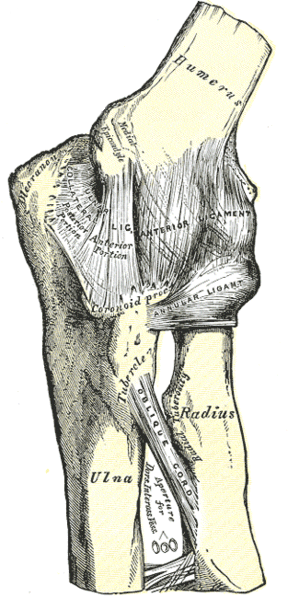Cubital
Tunnel Syndrome
(aka Ulnar Nerve Entrapment)
 What is Cubital
Tunnel Syndrome?
What is Cubital
Tunnel Syndrome?
Cubital Tunnel Syndrome is a condition
brought on by ongoing compression on the ulnar nerve
as it passes through the cubital tunnel (which
is the route the ulnar nerve takes past the
elbow). There is a bump of bone on the inner portion of the
elbow (medial epicondyle of the humerus) under
which the ulnar nerve passes. This location
is commonly called the 'funny bone'. At this point,
the ulnar nerve lies directly next to the
bone and is susceptible to pressure.
What are the Symptoms of Cubital Tunnel
Syndrome?
Common symptoms usually include pain,
numbness, and/or tingling, primarily in the 4th and 5th
fingers, and will occur whenever there is pressure on the
nerve.
To a lesser extent some individuals may experience weakness
while pinching, occasional clumsiness, and/or a tendency to
drop things. In severe cases, sensation may be lost and the
muscles in the hand may lose bulk and strength.
What Causes Cubital Tunnel Syndrome to
Develop?
Common causes include maintaining an
awkward position of the elbow for extended periods of time,
i.e. while sleeping or performing tasks requiring an awkward
repetitive bending and straightening of the elbow.
Another frequent source is extended periods of pressure on
the elbow on a hard surface such as when individuals brace
or support themselves on insufficiently padded arms of a
chair or a rigid tabletop for extended periods of time.
What Movements Should be Avoided if you
have Cubital
Tunnel Syndrome?
Resting or bracing the elbows on any hard
surface for extended periods of time i.e. hard
arm rests on a chair, or a desktop. Avoid prolonged
postures involving significantly bent elbows (i.e. holding a
receiver for an extended period should be obviated through the
use of a headset).
What Types of Products can be Used to
Help Prevent or Reduce the Symptoms and Incidence of Cubital Tunnel Syndrome?
Forearm
Supports can assisting in softening potential pressure
points while taking the weight of the arms off the shoulders
and back. Writing
Surfaces and Corner
Converters which reduce the reach for reference
documents and writing areas will assist in reducing the need
for awkward bending at the elbows and excessive reach.
